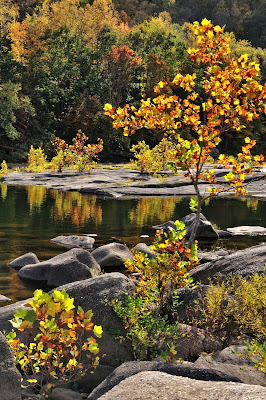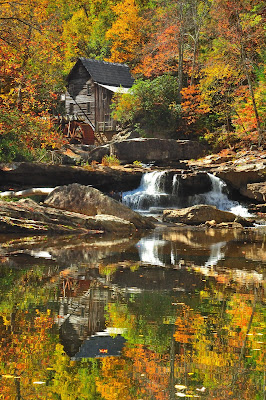If you like mountaintop panoramas and vistas packed with receding ridgelines, you’ll love the Hanging Rock Raptor Observatory (HRRO) in Monroe County. Perched atop of Peters Mountain on the Eastern Continental Divide, the HRRO has a 360 degree unobstructed view of the mountains and valleys of southern West Virginia and Virginia. Fifty miles to the east, the Peaks of Otter on the Blue Ridge Parkway are visible. Looking north, Cold Knob and the Beech Ridge Wind Farm in Greenbrier County, though 40 miles distant, are clearly seen. And the verdant valleys of Sweet Springs and Potts Creek stretch out for miles on either flank of Peters Mountain.
 |
| Hanging Rock Raptor Observatory |
Though the views are truly telescopic, there’s more to see at Hanging Rock. It’s a raptor observatory after all. “The 52-mile long mountain, among the longest in the Appalachians, helps produce thermal air currents that give migrating birds the lift needed to glide across vast segments of land while expending small amounts of energy” (Kenny Kemp). On a good day more than 500 migratory hawks can be spotted. Rarer but still seen are eagles, ospreys, and falcons.
 |
| Hanging Rock Raptor Observatory |
Counts of sightings of each species are meticulously maintained by volunteers who generally begin their watch in mid-August and end their work in December. Rodney Davis, a friendly volunteer we met while visiting last Thursday, told us that Mid-September is the busiest time for that’s when hundreds of Broad Wing Hawks migrate daily across Peters Mountain. October, he said, is prime time for eagles, which have been increasing in number in recent years. Mr. Davis also maintains the Observatory’s Website and Facebook Page.
 |
| Hanging Rock Raptor Observatory |
The history of the HRRO dates back to the 1930s when the State of West Virginia built the observatory as a fire watch tower. “In 1972, it was abandoned when planes took over the job of spotting fires. The Handlan Chapter, Brooks Bird Club, along with hawk watchers in Monroe County, took over its maintenance and upkeep” (George Hurley). Though vandals burned down the observatory in February 1996, the present structure was rebuilt according to the original plans provided by a local resident and was dedicated on June 10, 1997.
 |
| Inside the Hanging Rock Raptor Observatory |
With all to see at the HRRO, it’s worth a little effort to get to it. Fortunately, it’s only a 0.9 mile hike from the Trailhead parking (GPS: Lat. 37.509877, and Long. -80.438039). The trail follows a ridge line uphill and gains 380 feet in elevation. It’s rocky in certain stretches, but is well worn and easy to follow. In the fall wood aster and goldenrod line this forested trail. All in all, it’s a somewhat strenuous but enjoyable hike.
 |
| Hanging Rock Trail |
Driving to the HRRO is not difficult either. In fact, it’s a downright pleasant jaunt through rural countryside lined with lovely farms and fields. From the west the tower is just 14 miles from Union, WV, and 12 1/2 miles from Rock Camp, WV. (See map for roads and mileages). From the south, it’s just 5 miles on Limestone Hill Road from Waiteville, WV.
 |
| Map to Hanging Rock Raptor Observatory |
 |
| Rural Roads on the way to Hanging Rock |
Balanced atop a 3,812-foot-high peak in Monroe County, the HRRO has much to offer—unsurpassed vistas coupled with a unique opportunity to observed raptors in the wild. It deserves to be on every nature lovers bucket list.
 |
| Hanging Rock Raptor Observatory |

















































